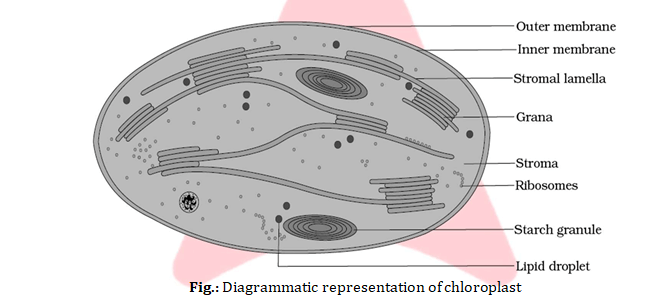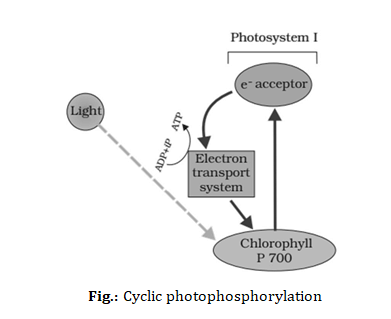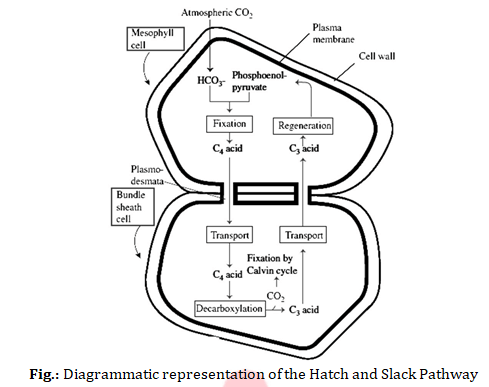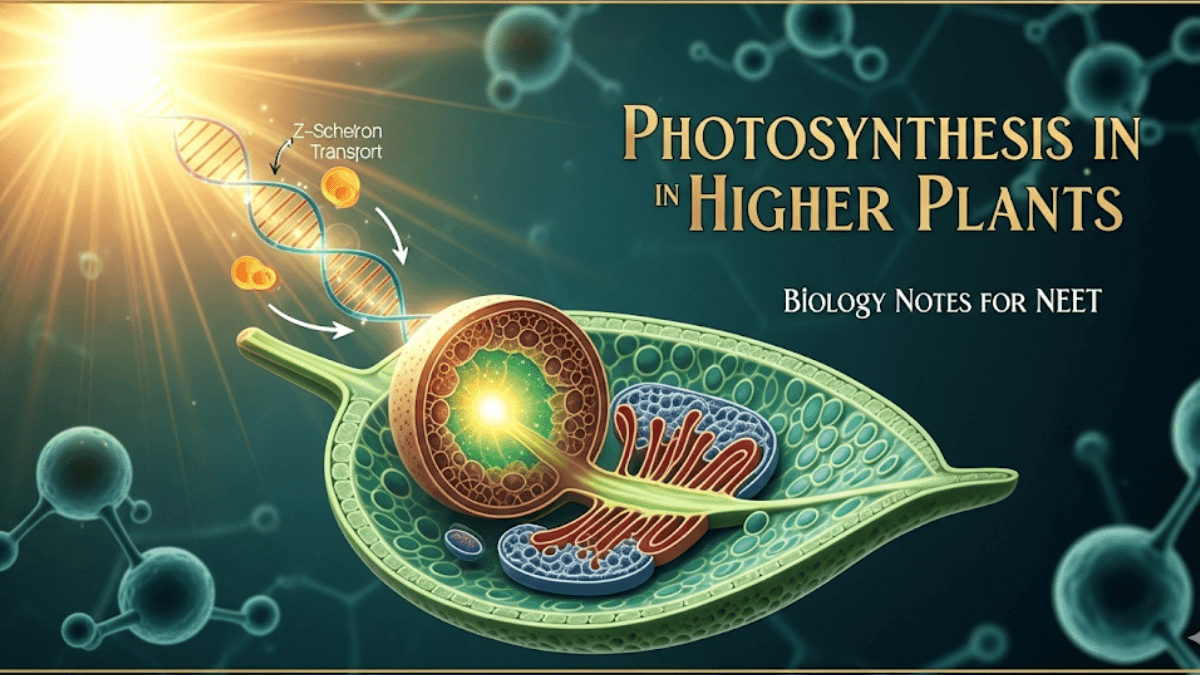Photosynthesis in Higher Plants Biology Notes: Green plants, often known as autotrophs, produce or synthesize the food they require through photosynthesis. Photosynthesis is the process by which green plant parts synthesize complex organic molecules (carbohydrates) in the presence of light, using CO2 and H2O. It is demonstrated by the following equation:
(Chlorophyll, sunlight)
6CO2 + 12H2O ———————–→ C6H12O6 + 6H2O + 6O2.
Photosynthesis in Higher Plants Biology Notes for NEET
What is Photosynthesis? Photosynthesis is an anabolic, endothermic, redox process. The first real oxygenic photosynthesis is observed in cyanobacteria. Green plants perform ‘photosynthesis’, a physicochemical process in which light energy drives the synthesis of organic substances.
The radiant energy of the sun is converted into chemical energy throughout this process. It is also known as CO2 assimilation. The use of energy from sunlight by plants in photosynthesis is the foundation of life on Earth.
Why is photo synthesis important for plants?
Photosynthesis is crucial for two reasons.
- It is the major source of all food on earth.
- It also releases oxygen into the atmosphere through green plants.
Important Notes of Photosynthesis in Higher Plants PDF
Photosynthesis in Higher Plants is a redox process that involves the oxidation of water and the reduction of CO2 to generate sugars. Thus, it is an oxidation-reduction reaction. Download the complete concept of this chapter with the practice question below –
Photosynthesis in Higher Plants PDF Download – Click here
Where does Photosynthesis take place?
Photosynthesis takes place in the green leaves of plants and other green parts of plants, like stems etc. The most active photosynthetic tissue in higher plants is the mesophyll of leaves. Chloroplasts present in mesophyll cells are those cell organelles in which photosynthesis takes place.
- The pigments are located in the thylakoid membrane of the chloroplast. Usually, the chloroplasts align themselves along the walls of the mesophyll cells, such that they get the optimum quantity of the incident light.
- Within the chloroplast, there is the membranous system consisting of grana, the stroma lamellae, and the fluid stroma.
- The membrane system is responsible for trapping the light energy and also for the synthesis of ATP and NADPH. In the stroma, enzymatic reactions incorporate CO2 into the plant, leading to the synthesis of sugar, which in turn forms starch. The former set of reactions, since they are directly light-driven, is called the light reactions.
- The latter are not directly light-driven but are dependent on the products of light reactions (ATP and NADPH). Hence, to distinguish the latter, they are called, by convention, dark reactions.

Distribution of chloroplasts
In photosynthetic eukaryotes, photosynthesis occurs in the subcellular organelle known as the chloroplast. This double membrane-enclosed organelle possesses a third system of membranes called thylakoids.
A stack of thylakoids forms a granum. Adjacent grana are connected by unstacked membranes called stroma lamellae. The fluid compartment surrounding the thylakoids, called the stroma
In eukaryotic algae, pigments are present in thylakoid lamellae, which are covered by a double membrane; thus, chloroplasts are present, but thylakoids do not pile up to form grana.
In higher plants, thylakoids pile up and form stalks of coin-like structures called grana (singular granum).
How Many Types Of Pigments Are Involved In Photosynthesis?
Pigments are substances that have the ability to absorb light at specific wavelengths.
A chromatographic separation of the leaf pigments shows that the colour of leaves is due to four pigments. Types of pigments in the chloroplasts:
(i) Chlorophyll a – Bright or blue-green in the chromatogram.
(ii) Chlorophyll b – Yellow-green
(iii) Xanthophylls – Yellow
(iv) Carotene – Yellow to yellow-orange
What are Light Reactions?
Light reactions or the ‘Photochemical’ phase include: Light absorption, water splitting and oxygen release, Formation of high-energy chemical intermediates, ATP and NADPH.
Several protein complexes are involved in the process. The pigments are organised into two discrete photochemical light-harvesting complexes (LHC) within the Photosystem I (PS I) and Photosystem II (PS II).
| PS-I | PS-II |
| It is located on the stacks of thylakoid and stroma lamellae membranes |
It is present on appressed portions of the thylakoid
membrane |
| P700 is a reaction centre in PS-I. |
P680 is reaction centre in PS-II.
|
| It is involved in both cyclic and non-cyclic photophosphorylation. |
It is involved only in non-cyclic photophosphorylation
|
| During non-cyclic photophosphorylation, it obtains electron from PS-II. |
It obtains electron through photolysis of water.
|
| Molecular oxygen is not evolved in this system. |
Molecular oxygen is evolved due to photolysis of
water. |
Electron Transport System
In the photosystem, the reaction centre chlorophyll a absorbs 680 nm wavelength of red light, causing electrons to become excited and jump into an orbit farther from the atomic nucleus. These electrons are picked up by an electron acceptor, which passes them to an electron transport system consisting of cytochromes. The process through which ATP is synthesised by cells (in mitochondria and chloroplasts) is named phosphorylation.
Photophosphorylation is the synthesis of ATP from ADP and inorganic phosphate in the presence of light. It is of two types:
- Cyclic Electron Transport Chain
- Non-Cyclic Electron Transport Chain or Z-Scheme
Cyclic Electron Transport Chain
The process of cyclic photophosphorylation involves only PS I and this process takes place in the stroma lamellae membrane. When only PS I is functional, the electron is circulated within the photosystem and the phosphorylation occurs, due to the cyclic flow of electrons.
Its reaction centre is P700 of Chl. a. When the reaction centre of PS I receives red light of 700 nm wavelength, they becomes excited and electrons are transferred to another acceptor molecule that has a greater redox potential. After losing the electron, the photocentre becomes oxidized.

Non-Cyclic Electron Transport Chain or Z-Scheme
It is carried out in collaboration of both PS-I and PS-II, in which the electron expelled by the excited photocentre does not return to it.
First in PS II, the P680 molecule absorbs 680 nm wavelength of red light, causing electrons to become excited and jump into an orbit that is farther from the atomic nucleus.
These electrons are picked up by an electron acceptor ,which passes them to an electron transport system of cytochromes. This movement of electrons is downhill on the redox potential scale. The electrons are then passed onto the pigments of PS I, without being used, as they pass through the electron transport chain.
Simultaneously, electrons in the reaction center of PS I (P700) are excited when they receive light of wavelength 700 nm and these electrons are transferred to another acceptor molecule that has a greater redox potential. These electrons are then moved downhill again to a molecule of NADP+. The addition of these electrons reduces the NADP+ to NADPH + H+.
The whole scheme of transfer of electrons, starting from the PS II, uphill to the acceptor, down the electron transport chain to PS I, excitation of electrons, transfer to another acceptor, and finally downhill to NADP+, causing it to be reduced to NADPH + H+, is called the Z-scheme.

Calvin cycle (C3 Cycle)
It is a thermosensitive activity that takes place in the stroma of the chloroplast. It occurs in all photosynthetic plants. In this process, ATP and NADPH are utilized, and carbohydrates are formed through the reduction & assimilation of CO2.
The first stable product identified was 3-phosphoglyceric acid (PGA), hence it is named the C3 pathway. Calvin cycle occurs in all photosynthetic plants, whether they have the C3 or the C4 pathway.
Stages of the Calvin Cycle
The Calvin cycle can be described under three stages:
- Carboxylation: It is the fixation of CO2 into a stable organic intermediate. In this, CO2 is utilised for the carboxylation of This reaction is catalysed by the enzyme RuBisCO and it results in the formation of two molecules of 3-PGA (3-Phosphoglyceric acid).
- Reduction: These reactions lead to the formation of glucose. The steps involve utilisation of two molecules of ATP for phosphorylation and two of NADPH for reduction, per molecule of CO₂ fixed. The fixation of six molecules of CO2 and six turns of the cycle are required for the removal of one molecule of glucose from the
- Regeneration: For the cycle to continue uninterrupted, regeneration of the CO₂ acceptor molecule is crucial. This step requires one ATP for phosphorylation to form To make one molecule of glucose six turns of the cycle are required. 18 ATP and 12 NADPH molecules are used to make a molecule of glucose. Hence, for every CO2 molecule entering the Calvin cycle, three molecules of ATP and two molecules of NADPH are required. For every CO2 molecule entering the Calvin cycle, three molecules of ATP and two molecules of NADPH are required. It is to meet this difference in the number of ATP and NADPH that the cyclic phosphorylation takes place. RuBisCO and many other enzymes of the Calvin cycle are regulated by light.

| In | Out |
| 6 CO2 | 1 Glucose |
| 18 ATP | 18 ADP |
| 12 NADPH | 12 NADP |
C₄ Cycle (Hatch And Slack Pathway)
Hatch & Slack (1967) discovered this alternative pathway for CO2 fixation, hence also called as Hatch and Slack cycle. It is also called the C4 cycle because the first stable compound is the 4C compound oxaloacetic acid (OAA) in this cycle. Plants that are adapted to dry tropical regions have the C4 pathway. e.g., Sugarcane, Maize, Sorghum etc. In these plants, double fixation of carbon dioxide occurs.
C4 plants are special as they have a special type of leaf anatomy, they can tolerate higher temperatures, they show a response to high intensities of light, they lack a wasteful process called photorespiration, thus they show greater productivity and higher yield as compared to the plants.
The C4 pathway requires the presence of two types of cells i.e., mesophyll cells and bundle sheath cells. The particularly large cells around the vascular bundles of C₄ plants are called bundle sheath cells. These cells may form several layers around the vascular bundles. They are characterised by having a large number of chloroplasts, grana are absent, thick walls impervious to gaseous exchange and no intercellular spaces. This special anatomy of leaves of the C4 plants is called ‘Kranz’ anatomy.

Importance of 𝑪𝟒 Plants
- They can tolerate saline conditions due to the abundant occurrence of organic acids (malic and oxaloacetic acid) in them, which lowers their water potential than that of soil.
- C4 pathway provides more CO2 for RuBP; the RuBP carboxylase enzyme is less sensitive to CO2.
- C4 plants are mostly found in hot deserts, where high temperature and high light intensity are These conditions stimulate photorespiration in plants, but photorespiration is absent in C4 plants.
Difference Between C3 and C4 Cycle
| 𝐂𝟑 Pathway | 𝐂𝟒 Pathway |
| 1. The primary acceptor of CO2 is RuBP carbon compound. – a five-carbon compound
2. The first stable product is 3-phosphoglycerate (3C-compound). 3. It occurs in the mesophyll cells of the leaves. 4. It is a slower process of carbon fixation. 5. 3ATP are consumed to fix one CO2 . |
1. The primary acceptor of CO₂ is PEP – a three- carbon compound.
2. The first stable product is oxaloacetic acid (4C- compound). 3. It occurs in the mesophyll and bundle-sheath cells of the leaves. 4. It is a faster process of carbon fixation. 5. 5 ATP are consumed to fix one CO2. |
Photorespiration
Photorespiration is a process that involves the loss of fixed carbon as CO₂ in plants in the presence of light. It is initiated in chloroplasts. This process does not produce ATP or NADPH and is a wasteful process.
Photorespiration occurs usually when there is a high concentration of oxygen. Under such circumstances, RuBisCO, the enzyme that catalyses the carboxylation of RuBP during the first step of the Calvin cycle, functions as an oxygenase. Some O₂ does bind to RuBisCO and hence, CO₂ fixation is decreased. The RuBP binds with O₂ to form one molecule of PGA (3C compound) and phosphoglycolate (2C compound) in the pathway of photorespiration.

Factors Affecting Photosynthesis
The rate of photosynthesis is very important in determining the yield of the plants, including crop plants. An understanding of the factors that affect photosynthesis is very necessary. The external factors include the availability of sunlight, temperature, CO₂ concentration, and water.










 CBSE Admit Card 2026 for Private & R...
CBSE Admit Card 2026 for Private & R...
 AILET 2026 AIR 1: Check Full Toppers Lis...
AILET 2026 AIR 1: Check Full Toppers Lis...
 AILET Result 2026 OUT, How to Download S...
AILET Result 2026 OUT, How to Download S...














